
ROYAL AIR FORCE. COMMON CORE AND DEPLOYMENT SKILLS AIDE-MEMOIRE
TASK 3. MAINTAINING THE S10 RESPIRATOR
You have to be able to:
Look after your respirator in such a way that it will function properly when you need it.
Study Notes
Your respirator is the most important piece of your NBC IPE. You will not survive a chemical attack if it does not work properly. It is an individual issue so looking after it is in your own interests.
In particular:
a. Don't let others wear it.
b. Always stow it correctly in the haversack (Task 1).
c. Don't cram extra items into the haversack.
d. Don't fiddle with its fittings.
e. Don't store close to radiators or hot pipes.
f. Don't put heavy objects on top of it.
g. Don't hang it up by head harness.
h. Keep water out of the canister.
i. Don't drink anything but water through the drinking device.
j. Take it out of the haversack once a week for a short time to avoid distortion of the facepiece.
k. Do not fold the harness back onto the facepiece as this leads to stretch.
l. Report any damage to your NBC Instructor at once.
Continued over:
As soon as possible after use:
m. Wipe the inside of the facepiece dry with a disinfecting cloth.
n. Clean the eyepieces with a moist, lint free cloth.
o. Wash out the drinking device if it has been used.
p. Report any damage at once.
If Fuller's Earth accumulates on the facepiece, remove the canister and dip the facepiece in warm slightly soapy water. Rinse in clean water, drain, shake, leave to dry naturally.
The S10 respirator and haversack should be inspected by, or under the supervision of, a qualified or authorised officer or NCO at the following intervals:
a. If not in constant use, every six months.
b. If in constant use, weekly.
c. If in storage, every 12 months.
Observe the following points in the care and use of the S10:
a. Check the valves regularly.
b. If misting occurs check the outlet valve is working correctly.
c. Use only a soft cloth to clean the eyepieces with mild soap to remove grease.
d. If eyepieces are scratched and you cannot carry out your duties change them at unit level.
e. Shave every 24 hours to ensure growth does not affect the respirator seal.
Practice
Note and follow the above instructions.
TASK 4. NERVE AGENT PRE-TREATMENT SET (NAPS)
You have to know:
When and how to take Nerve Agent Pre-treatment Set (NAPS) tablets.
You have to be able to:
Follow the correct drills for taking NAPS.
Study Notes
When there is a danger of nerve agent being used, you will be ordered to start a pre-treatment course of NAPS to increase your body's resistance. NAPS are issued in packs of 21 tablets. One tablet is to be taken every 8 hours. The interval is important so you must be able to continue taking them even when there is a vapour hazard. Taking NAPS more frequently can be harmful.
Taking NAPS in a Vapour Hazard
Ensure that no liquid agent is falling or take cover before following this drill.
Decontaminate your gloves, respirator and pocket/haversack containing NAPS.
Loosen neck fastening.
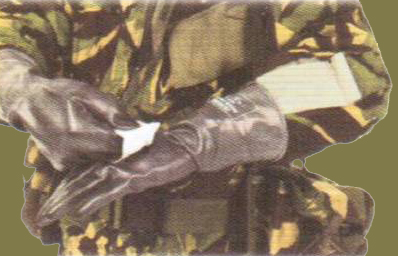
Take out NAPS.
Remove NAPS from the outer cover.

Press one tablet with thumb from clear side through aluminium foil into gloved hand.
Replace NAPS pack in cover and back in pocket/haversack.

Take a few deep breaths and hold last one.
Close eyes, grasp respirator PSM and pull the facepiece away from face and upward just far enough to give access to your mouth.

Place the tablet in your mouth and put it under your tongue.
Replace respirator, blow out hard and continue normal breathing, open eyes.
Swallow the tablet.
Adjust hood, fasten neck and pocket.
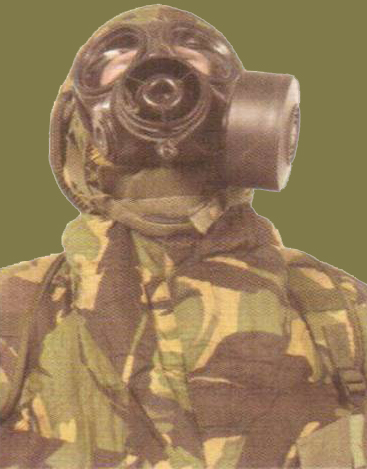
Practice
a. Learn when to take NAPS.
b. Practise the drill for taking NAPS in a vapour hazard.
TASK 5. NBC WARNING AND ALARMS
You have to be able to:
a. Identify NATO signs which warn of NBC contamination.
b. Recognise and know the meaning of both alarms and warnings.
Study Notes
Standard NATO signs are used to mark ground, vehicles and stores, facing outward from the contamination. The signs are triangular and coloured as shown in these examples.

When details of the contamination are known these are to be written on the front of the sign as follows:
a. Chemical and Biological (Gas/Bio):
(1) Type of Agent.
(2) Date/time contamination detected.
b. Radiological/Nuclear (Atom):
(1) Dose rate.
(2) Date/time of reading.
(3) Date/time of detonation which produced the contamination.
As soon as a NBC hazard is identified, a local alarm is to be given. On land this will take the form of one or more of the following:
a. Calls of "Gas, Gas, Gas" or "Fallout, Fallout, Fallout".
b. A succession of signals on vehicle or other horns (one second on, one second off) or the beating of metal objects to make a loud noise.
c. Interrupted warbling of a siren.
d. Audio-visual pyrotechnical producing a whistling sound and yellow, red, yellow lights.
e. Donning of respirators with appropriate signals.
f. Display of a BLACK sign, preferably tri-angular in shape.
All clear will be made known by:
a. Vocal "All clear".
b. Steady siren, sustained blast on horn, whistle or other wind instrument, when clear from both NBC and air attack.
c. Radiobroadcasts.
d. Removal of Black signs.
Practice
a. Draw NBC Warning signs and write on them examples of the information you would expect to find.
b. Learn to recognise the different alarms and their meaning.
TASK 6. CHEMICAL SAFETY RULE (CSR)
You have to know:
When to take action to protect yourself from chemical attack. To do this you must know:
a. The Chemical Safety Rule (CSR).
b. The reaction of liquid chemical agent on one colour detector paper.
Study Notes
When an enemy uses chemical agent he will try to achieve surprise. He may mix chemical with high explosive munitions, or use methods of delivery which you are unlikely to see or hear.
When chemical attack is expected you must be ready to follow the Chemical Safety Rule. In this case you must not wait for an order to mask but must do so automatically when circumstances arise which may mean you are being subjected to a chemical attack. The CSR can be modified by your commander. Survival will depend on your speed of reaction.
The Rule is as follows: If you:
a. Experience - a bombardment of any kind.
b. Sight - hostile or unknown low flying aircraft.
c. See - Suspicious:
(1) Mist.
(2) Smoke.
(3) Droplets.
(4) Splashes.
d. Smell - Anything unusual.
e. Notice -Symptoms in yourself or others such
as:
(1) Dimness of vision.
(2) Irritation of eyes.
(3) Sudden headache.
(4) Tightness in the chest.
(5) Running nose.
(6) Excessive salivation.
f. Hear - An alarm.
You must assume it is a chemical attack and carry out the Chemical Immediate Action Drill (see Task 7).
Another indication of chemical attack is if the grey detector paper issued with your IPE and worn on your suit and equipment displays navy blue spots. This will happen when liquid chemical agent lands on it. This is why it must be placed where such liquid drops are likely to fall.

Liquid Chemical Agent on One Colour Detector Paper
Note: NATO Standard Detector Paper turns blue
Practice
a. Learn the Chemical Safety Rule. Write it out several times.
b. Remember that one colour detector paper is turned blue by any liquid chemical agent.
TASK 7. CHEMICAL IMMEDIATE ACTION DRILL
You have to be able to:
Complete the Chemical Immediate Action (IA) drill correctly and be masked within 9 seconds.
Study Notes
Learn the sequence of the IA drill and practise it until you do it as an automatic reaction to an alarm. You must be able to mask within 9 seconds.
The IA drill is as follows:
Put on your respirator as in TASK 2.

Put on gloves.

Check the adjustment of all clothing and equipment.
Check detector papers. Look for any sign of liquid agent.

When you can complete the IA drill correctly and without thinking, you must then practise it while in your normal operational position, lying prone, in a slit trench and in a vehicle. The drill must be carried out IMMEDIATELY an attack is suspected.
Practice
a. Learn the sequence of the IA drill.
b. Practise the drill standing up wearing IPE.
c. Practise the drill in your normal operational setting.
TASK 8. CHEMICAL IMMEDIATE DECONTAMINATION
You have to be able to:
a. Carry out the chemical immediate decontamination (ID) drill when:
(1) You are contaminated before completing the IA drill.
(2) You are contaminated while wearing full IPE.
b. Use the DKP1 and DKP 2 to decontaminate your:
◉ Hands, face, ears, neck and hair.
◉ Respirator.
◉ Helmet.
◉ Overboots.
◉ Personal weapon, radio, etc.
Study Notes
If you are attacked with liquid chemical agent when not in full IPE you may get droplets on your hands, face, and the inside of your respirator as you put it on. All liquid agent must be removed before it penetrates your skin or you breathe in the vapour it gives off. There is no point in decontaminating until you can get under cover or liquid agent has stopped falling.
The ID drill involves the use of the DKP 1 and DKP 2. You are issued with a wallet containing 4 DKP 1 pads. The DKP 1 is a cloth pad filled with Fuller's Earth, a powder which will absorb liquid chemical agent and retain it. The best way of using the pad is to hold it by inserting 3 or 4 fingers through the centre of the pad and rapidly blotting the top of the pad over the suspected contamination. Then turn the pad over and bang it on the surface to release Fuller's Earth powder and follow this by rubbing the pad over the whole surface to spread the powder. The order is - BLOT - BANG - RUB. The DKP 1 is most suitable for decontaminating your gloves, hands, face and respirator. It is not safe to retain a used pad, so when finished break it open and use it on your overboots.
You are also issued with a DKP 2, a plastic puffer bottle containing Fuller's Earth. This is used to blow Fuller's Earth into places which are inaccessible to the DKP 1 pad. The DKP 2 is suitable for decontaminating your overboots and personal equipment. Powder from the DKP 2 is rubbed in using a DKP 1 pad on your gloved hand. Note: Thickened agent needs to be scraped off before using DKP.
Full ID Drill
Complete the IA Drill.
Decontaminate your hands, gloves, respirator and speech module and the areas of your IPE that you will touch in order to take off your respirator.

Gloves illustrated, drill is same for bare hands.
Blot.
Bang.
Rub.
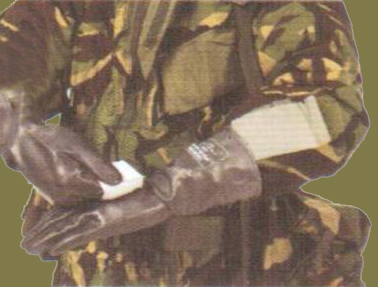

Remove helmet, place between knees, push back hood.
Hold breath. Remove your respirator. (Do this as often as necessary to complete drill). Blow out hard each time the respirator is replaced.
If agent has entered your eyes flush them with water (only if within 5 minutes of attack with blister agent).
Don Respirator.
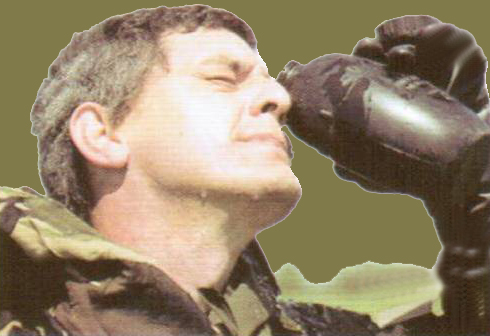
Open DKP 1.
Decontaminate face, ears, neck, hair, then inside of respirator (clean eyepieces later). Repeat as often as necessary.
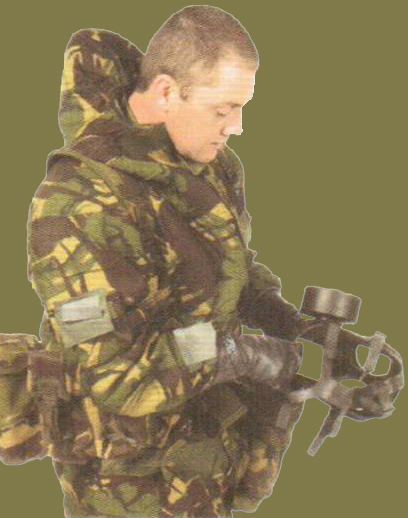
Decontaminate outside of respirator.

Open DKP 2. Decontaminate Helmet.
Decontaminate Overboots.
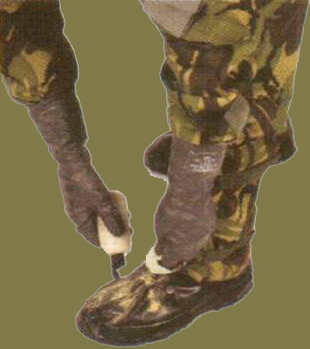
Modified ID Drill
If you are already in full IPE when you become contaminated you need only carry out a modified drill. This is necessary because after a time some agents may penetrate IPE. Decontamination will also reduce the danger of transfer. As before, get under cover or make sure no further liquid agent is falling before you start.
Decontaminate gloves, outside of respirator and overboots.
The Chemical ID drill is more quickly done in pairs but you must also be able to do it on your own.
Practice
a. Learn when to carry out the full and modified ID drills. Practise both drills.
b. Have someone check your drills.
c. Obtain a spare DKP 1 and DKP 2.
d. With the DKP 1 practise decontaminating:
(1) Your hands. Take care not to transfer contamination from one hand to the other.
(2) Your gloved hands. Again take care to avoid transfer of contamination.
(3) Your face, ears, neck and head.
(4) The inside and outside of your respirator.
e. With DKP 2 and DKP 1 practice decontaminating:
(1) The inside of your helmet and chin strap.
(2) Your overboots.
We have much more interesting information on this site.
Click MENU to check it out!
∎ cartalana.com© 2009-2025 ∎ mailto: cartalana@cartalana.com